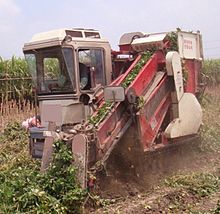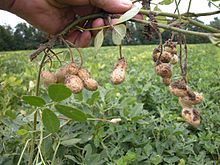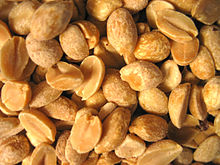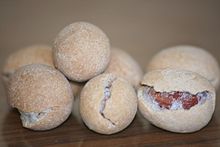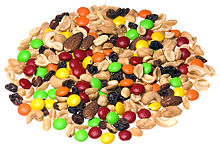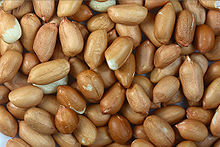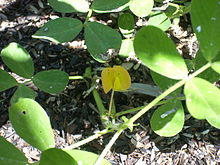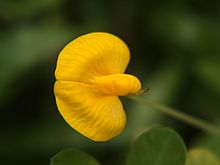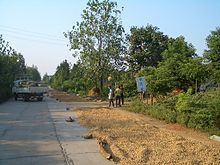
Peanut
Did you know...
SOS Children has tried to make Wikipedia content more accessible by this schools selection. Do you want to know about sponsoring? See www.sponsorachild.org.uk
| Peanut | |
|---|---|
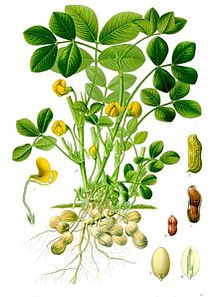 |
|
| Scientific classification | |
| Kingdom: | Plantae |
| (unranked): | Angiosperms |
| (unranked): | Eudicots |
| (unranked): | Rosids |
| Order: | Fabales |
| Family: | Fabaceae |
| Subfamily: | Faboideae |
| Tribe: | Aeschynomeneae |
| Genus: | Arachis |
| Species: | A. hypogaea |
| Binomial name | |
| Arachis hypogaea L. |
|
The peanut, or groundnut (Arachis hypogaea), is a species in the legume or "bean" family ( Fabaceae). The peanut was probably first domesticated and cultivated in the valleys of Paraguay. It is an annual herbaceous plant growing 30 to 50 cm (1.0 to 1.6 ft) tall. The leaves are opposite, pinnate with four leaflets (two opposite pairs; no terminal leaflet), each leaflet is 1 to 7 cm (⅜ to 2¾ in) long and 1 to 3 cm (⅜ to 1 inch) broad.
The flowers are a typical peaflower in shape, 2 to 4 cm (0.8 to 1.6 in) (¾ to 1½ in) across, yellow with reddish veining. Hypogaea means "under the earth"; after pollination, the flower stalk elongates causing it to bend until the ovary touches the ground. Continued stalk growth then pushes the ovary underground where the mature fruit develops into a legume pod, the peanut – a classical example of geocarpy. Pods are 3 to 7 cm (1.2 to 2.8 in) long, containing 1 to 4 seeds.
Peanuts are known by many other local names such as earthnuts, ground nuts, goober peas, monkey nuts, pygmy nuts and pig nuts. Despite its name and appearance, the peanut is not a nut, but rather a legume.
History
The domesticated peanut is an amphidiploid or allotetraploid, meaning that it has two sets of chromosomes from two different species, thought to be A. duranensis and A. ipaensis. These likely combined in the wild to form the tetraploid species A. monticola, which gave rise to the domesticated peanut. This domestication might have taken place in Paraguay or Bolivia, where the wildest strains grow today. Many pre-Columbian cultures, such as the Moche, depicted peanuts in their art.
Archeologists have dated the oldest specimens to about 7,600 years, found in Peru. Cultivation spread as far as Mesoamerica, where the Spanish conquistadors found the tlalcacahuatl (Nahuatl = "peanut", whence Mexican Spanish, cacahuate and French, cacahuète) being offered for sale in the marketplace of Tenochtitlan (Mexico City). The plant was later spread worldwide by European traders.
Although the peanut was mainly a garden crop for much of the colonial period of North America, it was mostly used as animal feed stock until the 1930s. In the United States, a US Department of Agriculture program (see below) to encourage agricultural production and human consumption of peanuts was instituted in the late 19th and early 20th centuries. George Washington Carver is well known for his participation in that program in which he developed hundreds of recipes for peanuts.
Cultivation
The orange-veined, yellow-petaled, pea-like flower of the Arachis hypogaea is borne in axillary clusters above ground. Following self-pollination, the flowers fade and wither. The stalk at the base of the ovary, called the pedicel, elongates rapidly, and turns downward to bury the fruits several inches in the ground, where they complete their development. The entire plant, including most of the roots, is removed from the soil during harvesting. The fruits have wrinkled shells that are constricted between pairs of the one to four (usually two) seeds per pod.
Peanuts grow best in light, sandy loam soil. They require five months of warm weather, and an annual rainfall of 500 to 1,000 mm (20 to 39 in) or the equivalent in irrigation water.
The pods ripen 120 to 150 days after the seeds are planted. If the crop is harvested too early, the pods will be unripe. If they are harvested late, the pods will snap off at the stalk, and will remain in the soil. They need an acidic soil to grow preferably with 5.9-7 pH.
Peanuts are particularly susceptible to contamination during growth and storage. Poor storage of peanuts can lead to an infection by the mold fungus Aspergillus flavus, releasing the toxic and highly carcinogenic substance aflatoxin. The aflatoxin-producing molds exist throughout the peanut growing areas and may produce aflatoxin in peanuts when conditions are favorable to fungal growth.
Harvesting occurs in two stages: In mechanized systems, a machine is used to cut off the main root of the peanut plant by cutting through the soil just below the level of the peanut pods. The machine lifts the "bush" from the ground and shakes it, then inverts the bush, leaving the plant upside down on the ground to keep the peanuts out of the soil. This allows the peanuts to dry slowly to a bit less than a third of their original moisture level over a period of three to four days. Traditionally, peanuts were pulled and inverted by hand.
After the peanuts have dried sufficiently, they are threshed, removing the peanut pods from the rest of the bush.
Cultivation in China
The peanut was introduced to China by Portuguese traders in the 17th century and another variety by American missionaries in the 19th century.
They became popular and are featured in many Chinese dishes, often being boiled. During the 1980s, peanut production began to increase so greatly that as of 2006, China was the world's largest peanut producer. A major factor in this increase was the household-responsibility system, which moved financial control from the government to the farmers.
Production
China leads in production of peanuts, having a share of about 41.5% of overall world production, followed by India (18.2%) and the United States of America (6.8%). In Europe, the leading producer is Greece, at roughly 2000 tons per year.
| Country | Production (Million Metric Tons) |
|---|---|
| 14.30 | |
| 6.25 | |
| 2.34 | |
| 1.55 | |
| 1.25 | |
| 1.00 | |
| 0.85 | |
| 0.71 | |
| 0.58 | |
| 0.50 | |
| World | 34.43 |
|
Source: USDA Foreign Agricultural Service: Table 13 Peanut Area, Yield, and Production |
|
Cultivars in the United States
Thousands of peanut cultivars are grown, with four major cultivar groups being the most popular: Spanish, Runner, Virginia, and Valencia. There are also Tennessee red and white groups. Certain cultivar groups are preferred for particular uses because of differences in flavor, oil content, size, shape, and disease resistance. For many uses, the different cultivars are interchangeable. Most peanuts marketed in the shell are of the Virginia type, along with some Valencias selected for large size and the attractive appearance of the shell. Spanish peanuts are used mostly for peanut candy, salted nuts, and peanut butter. Most Runners are used to make peanut butter.
The various types are distinguished by branching habit and branch length. There are numerous varieties of each type of peanut. There are two main growth forms, bunch and runner. Bunch types grow upright, while runner types grow near the ground.
Each year, new cultivars of peanuts are bred and introduced. Introducing a new cultivar may mean changes in the planting rate, adjusting the planter, harvester, dryer, cleaner, sheller, and the method of marketing.
Spanish group
The small Spanish types are grown in South Africa, and in the southwestern and southeastern US. Prior to 1940, 90% of the peanuts grown in Georgia, USA, were Spanish types, but the trend since then has been larger-seeded, higher-yielding, more disease-resistant cultivars. Spanish peanuts have a higher oil content than other types of peanuts, and in the US are now primarily grown in New Mexico, Oklahoma, and Texas.
Cultivars of the Spanish group include ‘Dixie Spanish’, ‘Improved Spanish 2B’, ‘GFA Spanish’, ‘Argentine’, ‘Spantex’, ‘Spanette’, ‘Shaffers Spanish’, ‘Natal Common (Spanish)’, "White Kernel Varieties’, ‘Starr’, ‘Comet’, ‘Florispan’, ‘Spanhoma’, ‘Spancross’, ‘OLin’, ‘Tamspan 90’, ‘AT 9899–14’, ‘Spanco’, ‘Wilco I’, ‘GG 2’, ‘GG 4’, ‘TMV 2’, and ‘Tamnut 06’.
Runner group
Since 1940, the southeastern US region has seen a shift to production of Runner group peanuts. This shift is due to good flavor, better roasting characteristics and higher yields when compared to Spanish types, leading to food manufacturers' preference for the use in peanut butter and salted nuts. Georgia's production is now almost 100% Runner type.
Cultivars of Runners include ‘Southeastern Runner 56-15’, ‘Dixie Runner’, ‘Early Runner’, ‘Virginia Bunch 67’, ‘Bradford Runner’, ‘Egyptian Giant’ (also known as ‘Virginia Bunch’ and ‘Giant’), ‘Rhodesian Spanish Bunch’ (Valencia and Virginia Bunch), ‘North Carolina Runner 56-15’, ‘Florunner’, ‘Virugard’, ‘Georgia Green’, ‘Tamrun 96’, ‘Flavor Runner 458’, ‘Tamrun OL01’, ‘Tamrun OL02’ ‘AT-120’, ‘Andru-93’, ‘Southern Runner’, ‘AT1-1’, ‘Georgia Brown’, ‘GK-7’,and ‘AT-108’.
Virginia group
The large seeded Virginia group peanuts are grown in the US states of Virginia, North Carolina, Tennessee, Texas, New Mexico, Oklahoma, and parts of Georgia. They are increasing in popularity due to demand for large peanuts for processing, particularly for salting, confections, and roasting in the shells.
Virginia group peanuts are either bunch or running in growth habit. The bunch type is upright to spreading. It attains a height of 45 to 55 cm (18 to 22 in), and a spread of 70 to 80 cm (28 to 31 in), with 80 to 90 cm (31 to 35 in) rows that seldom cover the ground. The pods are borne within 5 to 10 cm of the base of the plant.
Cultivars of Virginia type peanuts include ‘NC 7’, ‘NC 9’, ‘NC 10C’, ‘NC-V 11’, ‘VA 93B’, ‘NC 12C’, ‘VA-C 92R’, ‘Gregory’, ‘VA 98R’, ‘Perry’, ‘Wilson, ‘Hull’, ’AT VC-2’ and’ Shulamit’
Valencia group
Valencia group peanuts are coarse, and they have heavy reddish stems and large foliage. In the United States, large commercial production is primarily in the South Plains of West Texas and eastern New Mexico near and south of Portales, New Mexico, but they are grown on a small scale elsewhere in the South as the best-flavored and preferred type for boiled peanuts. They are comparatively tall, having a height of 125 cm (49 in) and a spread of 75 cm (30 in). Peanut pods are borne on pegs arising from the main stem and the side branches. Most of the pods are clustered around the base of the plant, and only a few are found several inches away. Valencia types are three- to five-seeded and smooth, with no constriction of the shell between the seeds. Seeds are oval and tightly crowded into the pods. Typical seed weight is 0.4 to 0.5 g. This type is used heavily for sale roasted and salted in-shell peanuts and peanut butter. Varieties include 'Valencia A' and 'Valencia C'.
Tennessee Red and Tennessee White groups
These are alike, except for the colour of the seed. Sometimes known also as Texas Red or White, the plants are similar to Valencia types, except the stems are green to greenish brown, and the pods are rough, irregular, and have a smaller proportion of kernels.
Uses
Varied applications
Peanuts have many uses. They can be eaten raw, used in recipes, made into solvents and oils, medicines, textile materials, and peanut butter, as well as many other uses. Popular confections made from peanuts include salted peanuts, peanut butter ( sandwiches, peanut candy bars, peanut butter cookies, and cups), peanut brittle, and shelled nuts (plain/roasted). Salted peanuts are usually roasted in oil and packed in retail-size plastic bags or hermetically sealed cans. Dry roasted salted peanuts are also marketed in significant quantities. Peanuts are often a major ingredient in mixed nuts because of their relative cost compared to Brazil nuts, cashews, walnuts, and so on. Although peanut butter has been a tradition on camping trips and the like because of its high protein content and because it resists spoiling for long periods of time, the primary use of peanut butter is in the home. Large quantities are also used in the commercial manufacture of sandwiches, candy, and bakery products. Boiled peanuts are a preparation of raw, unshelled green peanuts boiled in brine and often eaten as a snack. More recently, fried peanut recipes have emerged – allowing both shell and nut to be eaten. Peanuts are also used in a wide variety of other areas, such as cosmetics, nitroglycerin, plastics, dyes and paints.
Peanut oil
Peanut oil is often used in cooking, because it has a mild flavor and a relatively high smoke point. Due to its high monounsaturated content, it is considered more healthy than saturated oils, and is resistant to rancidity. There are several types of peanut oil including: aromatic roasted peanut oil, refined peanut oil, extra virgin or cold pressed peanut oil and peanut extract. In the United States, refined peanut oil is exempt from allergen labeling laws.
Peanut flour
Peanut flour is lower in fat than peanut butter, and is popular with chefs because its high protein content makes it suitable as a flavor enhancer. Peanut flour is used as a gluten-free solution.
Boiled peanuts
Boiled peanuts are a popular snack in the southern United States, as well as in India, China and West Africa.
Dry roasted peanuts
Dry peanuts can be roasted in the shell in a home oven if spread out one layer deep in a pan and baked at a temperature of 350°F or 177°C for 18–20 minutes.
Cuisine
South America
Peanuts are used in many sauces for South American meat dishes, especially rabbit. Peanuts are common in Peruvian cuisine, which marries native and European ingredients. For instance, roasted peanuts and hot peppers, both native to South America, appear with roasted onions, garlic, and oil—all of European origin—in a smooth sauce poured over boiled potatoes, a dish well known in the city Arequipa and called papas con ocopa. Another example is a fricassee combining a similar mixture with sautéed seafood or boiled and shredded chicken. These dishes are generally known as ajíes, meaning "hot peppers", such as ají de pollo and ají de mariscos. (Seafood ajíes may omit peanuts.)
Likewise, during Colonial times, the Spanish in Peru used peanuts to replace nuts unavailable in Peru but used extensively in Spanish cuisine, such as almonds, pine nuts, and other nuts, typically ground or as paste and mixed with rice, meats, and vegetables for dishes such as rice pilaf.
Southwest Asia
Crunchy coated peanuts, called kabukim in Hebrew, are a popular snack in Israel. Kabukim are commonly sold by weight at corner stores where fresh nuts and seeds are sold, though they are also available packaged. The coating typically consists of flour, salt, starch, lecithin, and sometimes sesame seeds. The origin of the name is obscure.(It may be derived from kabuk which means nutshell or husk in Turkish.) An additional variety of crunchy coated peanuts popular in Israel is "American peanuts". The coating of this variety is thinner, but harder to crack.
Another popular Israeli peanut snack, Bamba puffs, is similar in shape to Cheez Doodles, but are made of corn and flavored with peanut butter.
Southeast Asia
Peanuts are also widely used in Southeast Asian cuisine, particularly Indonesia, where they are typically made into a spicy sauce. Peanuts originally came to Indonesia from the Philippines, where the legume came from Mexico in times of Spanish colonization.
Common Indonesian peanut-based dishes include gado-gado, pecel, karedok and ketoprak, all vegetable salads mixed with peanut sauce, and the peanut-based sauce for satay.
In the Indian subcontinent, peanuts are known as a light snack by themselves, usually roasted and salted (sometimes with the addition of chilli powder), and often sold roasted in pod, or boiled with salt. They are also made into little dessert or sweet snack pieces by processing with refined sugar and jaggery. Indian cuisine uses roasted, crushed peanuts to give a crunchy body to salads; they are added whole (without pods) to leafy vegetable stews for the same reason. Another use of peanut oil as cooking oil. Most Indians use mustard, sunflower, and peanut oil for cooking. Peanuts are not native to India. They are thought to have come to India from Philippines. Notably, the name of this nut in northern parts of Tamil Nadu is 'மணிலாக் கொட்டை'- slang மல்லாக் கொட்டை- (Manila-k-kottai) means nut from Manila, the capital city of Philippines.
West Africa
Peanuts grow well in southern Mali and adjacent regions of the Ivory Coast, Burkina Faso, Ghana, Nigeria and Senegal. Peanut sauce, prepared with onions, garlic, peanut butter/paste, and vegetables such as carrots, cabbage ao cauliflower, can be vegetarian (the peanuts supplying ample protein) or prepared with meat, usually chicken.
Peanuts are used in the Mali meat stew maafe. In Ghana, peanut butter is used for peanut butter soup nkate nkwan. Crushed peanuts may also be used for peanut candies nkate cake and kuli-kuli, as well as other local foods such as oto. Peanut butter is also an ingredient in Nigeria's "African salad".
Peanut powder is an important ingredient in the spicy coating for kebabs in Nigeria and Ghana.
East Africa
Peanuts are a common ingredient of several types of relishes (dishes which accompany nshima) eaten by the tribes in Malawi and in the eastern part of Zambia, and these dishes are now common throughout both countries. Thick peanut butter sauces are also made in Uganda to go with rice and other starchy foods. Across East Africa, roasted peanuts (often in cones of newspaper) are a popular snack sold in the street.
North America
In the US, peanuts are used in candies, cakes, cookies, and other sweets. They are also enjoyed roasted and salted. Peanut butter is one of the most popular peanut-based foods in the US, and for four hundred years, recipes for peanut soup have been present in the South, Virginia in particular. In some southern portions of the US, peanuts are boiled for several hours until soft and moist. Peanuts are also deep-fried, shell and all.
Malnutrition
Peanuts are used to help fight malnutrition. Plumpy Nut, MANA Nutrition, and Medika Mamba are high-protein, high-energy and high-nutrient peanut-based pastes developed to be used as a therapeutic food to aid in famine relief. The World Health Organization, UNICEF, Project Peanut Butter and Doctors Without Borders have used these products to help save malnourished children in developing countries.
Other uses
Peanuts can be used like other legumes and grains to make a lactose-free milk-like beverage, peanut milk. Peanut plant tops are used for hay.
Low-grade or culled peanuts not suitable for the edible market are used in the production of peanut oil for manufacturing. The protein cake (oilcake meal) residue from oil processing is used as an animal feed and as a soil fertilizer. Low-grade peanuts are also widely sold as a garden bird feed.
Peanuts have a variety of industrial end uses. Paint, varnish, lubricating oil, leather dressings, furniture polish, insecticides, and nitroglycerin are made from peanut oil. Soap is made from saponified oil, and many cosmetics contain peanut oil and its derivatives. The protein portion is used in the manufacture of some textile fibers. Peanut shells are used in the manufacture of plastic, wallboard, abrasives, fuel, cellulose (used in rayon and paper) and mucilage (glue). Rudolf Diesel ran some of the first engines that bear his name on peanut oil and it is still seen as a potentially useful fuel.
Nutritional value
| Nutritional value per 100 g (3.5 oz) | |
|---|---|
| Energy | 2,385 kJ (570 kcal) |
| Carbohydrates | 21 g |
| - Sugars | 0.0 g |
| - Dietary fibre | 9 g |
| Fat | 48 g |
| - saturated | 7 g |
| - monounsaturated | 24 g |
| - polyunsaturated | 16 g |
| Protein | 25 g |
| - Tryptophan | 0.2445 g |
| - Threonine | 0.859 g |
| - Isoleucine | 0.882 g |
| - Leucine | 1.627 g |
| - Lysine | 0.901 g |
| - Methionine | 0.308 g |
| - Cystine | 0.322 g |
| - Phenylalanine | 1.300 g |
| - Tyrosine | 1.020 g |
| - Valine | 1.052 g |
| - Arginine | 3.001 g |
| - Histidine | 0.634 g |
| - Alanine | 0.997 g |
| - Aspartic acid | 3.060 g |
| - Glutamic acid | 5.243 g |
| - Glycine | 1.512 g |
| - Proline | 1.107 g |
| - Serine | 1.236 g |
| Water | 4.26 g |
| Thiamine (vit. B1) | 0.6 mg (52%) |
| Niacin (vit. B3) | 12.9 mg (86%) |
| Pantothenic acid (B5) | 1.8 mg (36%) |
| Vitamin B6 | 0.3 mg (23%) |
| Folate (vit. B9) | 246 μg (62%) |
| Vitamin C | 0.0 mg (0%) |
| Calcium | 62 mg (6%) |
| Iron | 2 mg (15%) |
| Magnesium | 184 mg (52%) |
| Phosphorus | 336 mg (48%) |
| Potassium | 332 mg (7%) |
| Zinc | 3.3 mg (35%) |
| Percentages are relative to US recommendations for adults. Source: USDA Nutrient Database |
|
Peanuts are rich in nutrients, providing over 30 essential nutrients and phytonutrients. Peanuts are a good source of niacin, folate, fibre, vitamin E, magnesium and phosphorus. They also are naturally free of trans-fats and sodium, and contain about 25% protein (a higher proportion than in any true nut).
Niacin
Peanuts are a good source of niacin, and thus contribute to brain health and blood flow.
Antioxidants
Recent research on peanuts has found antioxidants and other chemicals that may provide health benefits. New research shows peanuts rival the antioxidant content of many fruits. Roasted peanuts rival the antioxidant content of blackberries and strawberries, and are far richer in antioxidants than carrots or beets. Research published in the journal Food Chemistry shows that peanuts contain high concentrations of antioxidant polyphenols, primarily a compound called p-coumaric acid, and that roasting can increase peanuts' p-coumaric acid levels, boosting their overall antioxidant content by as much as 22%.
Resveratrol
Peanuts are a significant source of resveratrol, a chemical associated with but not proven to cause a reduction in risk of cardiovascular disease and cancer.
The average amount of resveratrol in one ounce of commonly eaten peanuts (15 whole peanut kernels) is 73 μg.
Coenzyme Q10
Peanuts are a source of coenzyme Q10, as are oily fish, beef, soybeans and spinach.
Health concerns
Allergies
Some people (1–2% of the United States population) have mild to severe allergic reactions to peanut exposure; symptoms can range from watery eyes to anaphylactic shock, which can be fatal if untreated. For these individuals, eating a small amount of peanuts can cause a reaction. Because of their widespread use in prepared and packaged foods, the avoidance of peanuts is difficult. Some foods processed in facilities which also handle peanuts may carry warnings on their labels indicating such.
A hypothesis of the development of peanut allergy has to do with the way peanuts are processed in North America versus other countries, such as Pakistan and China, where peanuts are widely eaten. According to a 2003 study, roasting peanuts, as more commonly done in North America, causes the major peanut allergen Ara h2 to become a stronger inhibitor of the digestive enzyme trypsin, making it more resistant to digestion. Additionally, this allergen has also been shown to protect Ara h1, another major peanut allergen, from digestion — a characteristic further enhanced by roasting.
Another hypothesis, called the hygiene hypothesis, states that a lack of early childhood exposure to infectious agents like germs and parasites could be causing the increase of food allergies.
Recent (2008) studies comparing age of peanut introduction in Great Britain with introduction in Israel appear to show that delaying exposure to peanuts can dramatically increase the risk of developing peanut allergies.
Results from some animal studies (and limited evidence from human subjects) suggest that the dose of peanuts is an important mediator of peanut sensitisation and tolerance; low doses tend to lead to sensitisation and higher doses tend to lead to tolerance.
Peanut allergy has been associated with the use of skin preparations containing peanut oil among children, but the evidence is not regarded as conclusive. Peanut allergies have also been associated with family history and intake of soy products.
Though the allergy can last a lifetime, another 2003 study indicates that 23.3% of children will outgrow a peanut allergy.
Some school districts in the United States have banned peanuts. There are experimental techniques which appear to have desensitized some allergic individuals. The most popular technique, oral immunotherapy, works to create desensitization in those allergic by feeding them small amounts of peanuts until their body becomes desensitized. Some progress is possibly being made in the UK, where researchers at Cambridge are studying the effectiveness of the desensitization technique.
Research indicates that refined peanut oil will not cause allergic reactions in most people with peanut allergies. However, crude (unrefined) peanut oils are strongly flavoured, and have been shown to contain protein, which may cause allergic reactions. In a randomized, double-blind crossover study, 60 people with proven peanut allergy were challenged with both crude peanut oil and refined peanut oil. The authors conclude, "Crude peanut oil caused allergic reactions in 10% of allergic subjects studied and should continue to be avoided." They also state, "Refined peanut oil does not seem to pose a risk to most people with peanut allergy." However, they point out that refined peanut oil can still pose a risk to peanut-allergic individuals if oil that has previously been used to cook foods containing peanuts is reused.
Contamination with aflatoxin
Peanuts may be contaminated with the mold Aspergillus flavus which produces a carcinogenic substance called aflatoxin. Lower quality specimens, particularly where mold is evident, are more likely to be contaminated. The United States Department of Agriculture (USDA) tests every truckload of raw peanuts for aflatoxin; any containing aflatoxin levels of more than 15 parts per billion are destroyed. The peanut industry has manufacturing steps in place to ensure all peanuts are inspected for aflatoxin. Peanuts are also processed at a high temperature to ensure any microorganisms are killed.
Cardiovascular disease
A 1974 study suggested that consuming large amounts of peanut oil can cause clogging of the arteries. Robert Wissler of the University of Chicago reported that diets high in peanut oil, when combined with high dietary cholesterol intake, clogged the arteries of Rhesus monkeys more than butterfat. However, subsequent work has cast serious doubt on those findings. In the Rhesus study, monkeys were being fed 20 times higher than normal dietary quantities of cholesterol in addition to peanut oil. When a similar study was performed without abnormal doses of cholesterol, no such effect was seen. In fact, peanut oil has been found to lower LDL cholesterol without reducing beneficial HDL cholesterol.
U.S. Department of Agriculture (USDA) program
George Washington Carver is often credited with inventing 300 different uses for peanuts (which, contrary to popular belief, did not include peanut butter but did include salted peanuts). Carver was one of many USDA researchers who encouraged cotton farmers in the South to grow peanuts instead of, or in addition to, cotton, because cotton had depleted so much nitrogen from the soil, and one of the peanut's properties as a legume is to put nitrogen back into the soil (a process known as nitrogen fixation). Rising demand for peanuts in the early 20th century was due to a shortage of plant oils during World War I and the growing popularity of peanut butter, roasted peanuts and peanut candies. Peanut products originating around the early 20th century include many brands still sold today such as Cracker Jack (1893), Planters peanuts (1906), Oh Henry! candy bar (1920), Baby Ruth candy bar (1920), Butterfinger candy bar (1923), Mr. Goodbar candy bar (1925), Reese's Peanut Butter Cup (1925), and Peter Pan (peanut butter) (1928).
Peanuts were designated by the U.S. Congress to be one of America's basic crops. To protect domestic industry by keeping prices artificially high, the United States Department of Agriculture (USDA) aids peanut farmers through commodity programs. In the 2008 Farm Bill, the marketing quota for peanuts was eliminated and the Price Support Program was switched to a Direct and Counter-Cyclical Payment Program. Direct and counter-cyclical payments provide benefits to producers with eligible historical production of peanuts whenever the effective price is less than the targeted price.
Trade

Although India and China are the world's largest producers of peanuts, they account for a small part of international trade because most of their production is consumed domestically as peanut oil. Exports of peanuts from India and China are equivalent to less than 4% of world trade. The major producers/exporters of peanuts are the United States, Argentina, Sudan, Senegal, and Brazil. These five countries account for 71% of total world exports. In recent years, the United States has been the leading exporter of peanuts.
The major peanut importers are the European Union (EU), Canada, and Japan. These three areas account for 78% of the world's imports. Most of Canada's peanut butter is processed from Chinese peanuts. Two thirds of U.S. imports are roasted, unshelled peanuts. The major suppliers are Taiwan, Malaysia, Hong Kong, Mainland China, and Canada. The principal suppliers of shelled peanut imports are Argentina and Canada. Imports of peanut butter from Argentina are in the form of a paste and must be further processed. Other minor suppliers of peanut butter include Malawi, China, India, and Singapore.
The European Union is the largest consuming region in the world that does not produce peanuts. All of its consumption is supplied by imports. Consumption of peanuts in the EU is primarily as food, mostly as roasted-in-shell peanuts and as shelled peanuts used in confectionery and bakery products.
The average annual U.S. imports of peanuts are less than 0.5% of U.S. consumption.
Georgia is the leading peanut producing state in the U.S., followed by Texas and Alabama, respectively. About half of all peanuts produced in the United States are grown within a 100 mi (160 km) radius of Dothan, Alabama. Dothan is home to the National Peanut Festival established in 1938 and held each fall to honour peanut growers and celebrate the harvest.
Ninety percent of India's production is processed into peanut oil. Only a nominal amount of hand-picked select-grade peanuts are exported. India prohibits the importation of all oil seeds, including peanuts.



